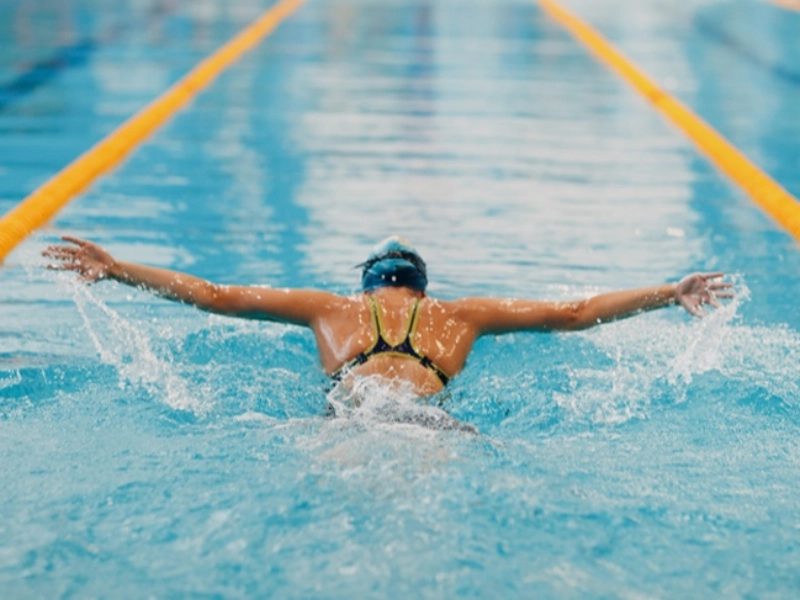Swimming is an excellent full body, low impact exercise suitable for individuals of all ages and fitness levels. It's also a fantastic addition to harder impact workouts for people who have joint problems or injuries.
Swimming uses all of the major muscular groups, unlike most other forms of cardiac exercise. Not only are down-and-backs a common swim exercise, but most swim routines also incorporate interval training with brief pauses in between.
Exercise for the Heart

Advertisement
One of the best forms of aerobic exercise is swimming. Exercise develops strength and cardiorespiratory endurance while burning hundreds of calories in an hour. Additionally, the movement lowers the risk of diabetes, high blood pressure, and heart disease.
Those with musculoskeletal problems or arthritis who are unable to perform weight-bearing activities can find the workout more manageable due to the water's ability to sustain up to 90% of their body weight. Swimming can also be combined with other water-based exercises, such jump squats or deep-water jogging, to vary up your program and test different muscle groups.
Swimming is a full-body workout that targets the majority of the main muscles in the body, such as the arms, shoulders, back, chest, and core. It fortifies the muscles of the deltoids and rotator cups, the latissimus dorsi and trapezius, and the triceps and biceps. It also works the calves, hamstrings, quadriceps, and hips. It causes endorphins to be released, which improve mood and assist with stress management.
Strength Development

Swimming provides you with a full-body workout by using all of your muscles. In order to conserve energy and avoid damage, it's critical to concentrate on proper technique. Steer clear of exerting too much force on your arms through the water as this will only cause fatigue and strain on your shoulders.
Although swimming is often associated with upper-body exercises, it also involves strong leg movements. Consider incorporating strength training activities into your pool workouts for a well-rounded fitness experience. Stand in water deep enough to submerge your shoulders and perform arm lifts for three sets of ten repetitions to strengthen your arms.
For an excellent lower-body workout, you may also use a pull buoy to strengthen your arms, lats, and shoulders or a kickboard to isolate your legs. These drills assist in varying your lap swim and maintain the intensity of your training. Make sure to consult your healthcare practitioner first if you haven't tried these procedures, and gradually increase the frequency of your routine.
Exercise for Endurance

Swimming is a heart- and lung-strengthening cardiovascular workout that works well. At a rate that varies based on your weight and speed, it also burns a large amount of calories. It can protect against type 2 diabetes, heart disease, and stroke. The muscles in the shoulders, back, arms, chest, abdomen, and core become more resilient by swimming.
The resistance of the water offers an intense exercise that can be enhanced with equipment like kickboards and pull buoys. By using these gadgets, you can improve the workout's muscle-strengthening component and break up the monotony of long, nonstop lap swimming.
Swimming activates as many as 50 different muscle groups simultaneously since it requires the body to be propelled against a lot of resistance. For this reason, a large number of players from various sports also use it for their fitness training. For instance, distance runners frequently use it, and the length of the race determines how much of it is necessary.
Adaptability Education

Since water can support up to 90% of your body weight, swimming is an excellent approach to improve flexibility. Moreover, a lot of pools come equipped with fitness gear like kickboards, fins, and paddles, which can help you mix up your routine and incorporate new exercises.
To mix up the monotony of long lap swims and target different muscle groups, you can also try additional water-based activities. For example, try standing up in the shallow end with your back to the wall and moving forward with one knee while keeping the other knee on the floor. Finish all three sets of ten reps.
Stretching and warming up before entering the pool is crucial, just like with any other form of exercise. This might help you stay injury-free and energized during your swimming workout. It has been demonstrated that regular swimming reduces the chance of developing chronic illnesses like Type 2 diabetes and heart disease. Additionally, it has been connected to reduced blood pressure and enhanced mental well-being.
Advertisement












